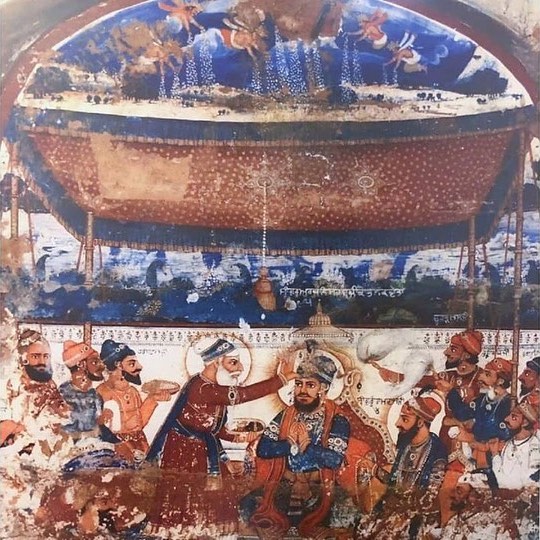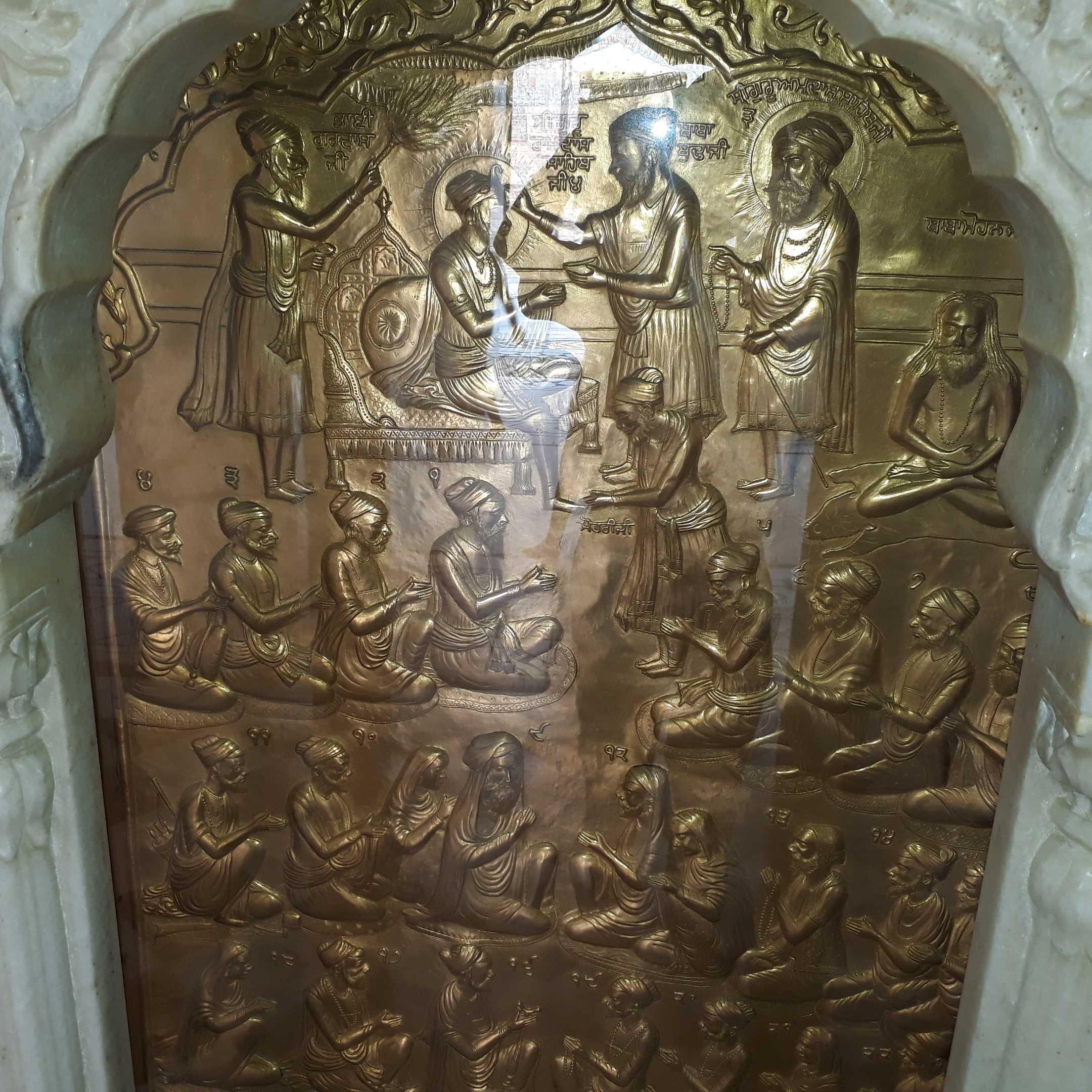|
Asa Di Vaar
''Asa di Var'' (Gurmukhi: ਆਸਾ ਦੀ ਵਾਰ) meaning "A ballad of hope", is a collection of 24 stanzas (''pauris'') in the Guru Granth Sahib, from ang 462 to ang 475. Some people argue that the founder of Sikhism, Guru Nanak Dev, wrote the first 9 stanzas together on one occasion and later wrote 15 more on a different occasion; however, some Sikh scholars believe that the whole ''vaar'' was written at the same place as the ''vaar'' itself proceeds in a definite uniformity. The whole ''vaar'' was compiled by Guru Arjan, the fifth Guru, in 1604 AD. Overview When Guru Arjan was compiling the Guru Granth Sahib, he added a few ''sloks'' of Guru Nanak and in some cases Guru Angad, the second Guru. These sloks are tied together in a way that they relate to the same theme as highlighted in the pauri. In its present form, the ''Asa Di Var'' contains a few more shabads recited by Guru Ram Das Guru Ram Das (Gurmukhi: ਗੁਰੂ ਰਾਮ ਦਾਸ, pronunciation: ; 24 Se ... [...More Info...] [...Related Items...] OR: [Wikipedia] [Google] [Baidu] |
Gurmukhi
Gurmukhī ( , Shahmukhi: ) is an abugida developed from the Laṇḍā scripts, standardized and used by the second Sikh guru, Guru Angad (1504–1552). Commonly regarded as a Sikh script, Gurmukhi is used in Punjab, India as the official script of the Punjabi language. In the past, the script was also employed to write scientific and poetic literature from both Sanskritic and Persian traditions in the Braj language. The primary scripture of Sikhism, the Guru Granth Sahib, is written in Gurmukhī, in various dialects and languages often subsumed under the generic title '' Sant Bhasha'' or "saint language", in addition to other languages like Persian and various phases of Indo-Aryan languages. Modern Gurmukhī has thirty-five original letters, hence its common alternative term ''paintī'' or "the thirty-five", plus six additional consonants, nine vowel diacritics, two diacritics for nasal sounds, one diacritic that geminates consonants and three subscript characters. The sc ... [...More Info...] [...Related Items...] OR: [Wikipedia] [Google] [Baidu] |
Stanza
In poetry, a stanza (; from Italian ''stanza'', ; ) is a group of lines within a poem, usually set off from others by a blank line or indentation. Stanzas can have regular rhyme and metrical schemes, but they are not required to have either. There are many different forms of stanzas. Some stanzaic forms are simple, such as four-line quatrains. Other forms are more complex, such as the Spenserian stanza. Fixed verse poems, such as sestinas, can be defined by the number and form of their stanzas. The stanza has also been known by terms such as ''batch'', ''fit'', and ''stave''. The term ''stanza'' has a similar meaning to ''strophe'', though ''strophe'' sometimes refers to an irregular set of lines, as opposed to regular, rhymed stanzas. Even though the term "stanza" is taken from Italian, in the Italian language the word "strofa" is more commonly used. In music, groups of lines are typically referred to as '' verses''. The stanza in poetry is analogous with the paragrap ... [...More Info...] [...Related Items...] OR: [Wikipedia] [Google] [Baidu] |
Guru Granth Sahib
The Guru Granth Sahib (, ) is the central holy religious scripture of Sikhism, regarded by Sikhs as the final, sovereign and eternal Guru following the lineage of the ten human gurus of the religion. The Adi Granth (), its first rendition, was compiled by the fifth guru, Guru Arjan (1564–1606). Its compilation was completed on 29 August 1604 and first installed inside the Golden Temple in Amritsar on 1 September 1604. Baba Buddha was appointed the first Granthi of the Golden Temple. Shortly afterwards Guru Hargobind added Ramkali Ki Vaar. Later, Guru Gobind Singh, the tenth Sikh guru, added hymns of Guru Tegh Bahadur to the Adi Granth and affirmed the text as his successor. This second rendition became known as the Guru Granth Sahib and is also sometimes referred to as the Adi Granth.Adi Granth Encyclopaedia Brit ... [...More Info...] [...Related Items...] OR: [Wikipedia] [Google] [Baidu] |
Guru Nanak Dev
Guru ( ; IAST: ''guru'') is a Sanskrit term for a "mentor, guide, expert, or master" of certain knowledge or field. In pan-Indian traditions, a guru is more than a teacher: traditionally, the guru is a reverential figure to the disciple (or '' shisya'' in Sanskrit, literally ''seeker f knowledge or truth'' or student, with the guru serving as a "counsellor, who helps mould values, shares experiential knowledge as much as literal knowledge, an exemplar in life, an inspirational source and who helps in the spiritual evolution of a student". Whatever language it is written in, Judith Simmer-Brown says that a tantric spiritual text is often codified in an obscure twilight language so that it cannot be understood by anyone without the verbal explanation of a qualified teacher, the guru. A guru is also one's spiritual guide, who helps one to discover the same potentialities that the ''guru'' has already realized. The oldest references to the concept of ''guru'' are found in the ea ... [...More Info...] [...Related Items...] OR: [Wikipedia] [Google] [Baidu] |
Vaar
The Vār or Vaar (, ), in Punjabi poetry, is a heroic ode or ballad which generally narrates legend such as stories of Punjabi folk heroes or a historical event.''The Encyclopaedia of Indian Literature (Volume One - A to Devo)''. Amaresh Datta, ed. Sahitya Akademi: 2006, 352. Examples include the feats of Dulla Bhatti and Raja Rasalu, Amir Khusrau's Vaar for Ghazi Malik who took the throne of Delhi in 1320, the Vaar of Shaikh Khokhar, Najabat's ''Nadar Shah di Var'' which describes the invasion of India by Nadir Shah in 1739, and the ''Chatthian di Vaar'' which commemorates Pir Muhammad Chattha's famous rivalry with the Sikhs. The Var has also been used to evoke the mood of devotion or sacrifice, as in Guru Gobind Singh's '' Chandi di Var'', or to narrate the mystical experience of a Pir, Bhagat or Guru. See also * Punjabi Qisse * Punjabi folklore * Dhadi (music) * Raga A raga ( ; , ; ) is a melodic framework for improvisation in Indian classical music akin to a mu ... [...More Info...] [...Related Items...] OR: [Wikipedia] [Google] [Baidu] |
Guru Arjan
Guru Arjan (Gurmukhi: ਗੁਰੂ ਅਰਜਨ, pronunciation: ; 15 April 1563 – 30 May 1606) was the fifth of the ten total Sikh Gurus. He compiled the first official edition of the Sikh scripture called the Adi Granth, which later expanded into the Guru Granth Sahib. He is regarded as the first of the two Gurus martyred in the Sikh faith. Guru Arjan was born in Goindval, in the Punjab, the youngest son of Bhai Jetha, who later became Guru Ram Das, and Mata Bhani, the daughter of Guru Amar Das. He completed the construction of the Darbar Sahib at Amritsar, after the fourth Sikh Guru founded the town and built a sarovar. Arjan compiled the hymns of previous Gurus and of other saints into Adi Granth, the first edition of the Sikh scripture, and installed it in the Harimandir Sahib. Guru Arjan reorganized the masand system initiated by Guru Ram Das, by suggesting that the Sikhs donate, if possible, one-tenth of their income, goods or service to the Sikh organization ... [...More Info...] [...Related Items...] OR: [Wikipedia] [Google] [Baidu] |
Shloka
Shloka or śloka ( , from the root , Macdonell, Arthur A., ''A Sanskrit Grammar for Students'', Appendix II, p. 232 (Oxford University Press, 3rd edition, 1927).) in a broader sense, according to Monier-Williams's dictionary, is "any verse or stanza; a proverb, saying"; but in particular it refers to the 32- syllable verse, derived from the Vedic '' anuṣṭubh'' metre, used in the '' Bhagavad Gita'' and many other works of classical Sanskrit literature. In its usual form it consists of four '' pādas'' or quarter-verses, of eight syllables each, or (according to an alternative analysis) of two half-verses of 16 syllables each. The metre is similar to the Vedic '' anuṣṭubh'' metre, but with stricter rules. The ''śloka'' is the basis for Indian epic poetry, and may be considered the Indian verse form ''par excellence'', occurring as it does far more frequently than any other metre in classical Sanskrit poetry. The ''śloka'' is the verse-form generally used in the '' Maha ... [...More Info...] [...Related Items...] OR: [Wikipedia] [Google] [Baidu] |
Guru Angad
Guru Angad (31 March 1504 – 29 March 1552; , ) was the second of the ten Sikh gurus of Sikhism. After meeting Guru Nanak, the founder of Sikhism, becoming a Sikh, and serving and working with Nanak for many years, Nanak gave Lehna the name Angad ("my own limb"), and chose Angad as the second Sikh Guru. After the death of Nanak in 1539, Angad led the Sikh tradition. He is remembered in Sikhism for adopting and formalising the Gurmukhi alphabet. He began the process of compiling the hymns of Nanak and contributed 62 or 63 ''Saloks'' of his own. Instead of his own son, he chose his disciple Amar Das as his successor and the third Guru of Sikhism. Biography Early life Angad was born on 31 March 1504 with the birth name of Lehna (also transliterated as Lahina) in the village of Matte-di-Sarai (now Sarainaga) in Muktsar district of the Punjab region. He was the son of a small but successful trader named Pheru Mal. His mother's name was Mata Ramo (also known as Mata Sabhirai, ... [...More Info...] [...Related Items...] OR: [Wikipedia] [Google] [Baidu] |
Guru Ram Das
Guru Ram Das (Gurmukhi: ਗੁਰੂ ਰਾਮ ਦਾਸ, pronunciation: ; 24 September 1534 – 1 September 1581), sometimes spelled as Guru Ramdas, was the fourth of the ten Sikh gurus. He was born to a family based in Lahore, who named him Bhai Jetha. He was orphaned at age seven; and thereafter grew up with his maternal grandmother in a village. At age 12, Bhai Jetha and his grandmother moved to Goindwal, Goindval, where they met Guru Amar Das, the third leader of Sikhism. The boy accepted the guru as his mentor, served him, and eventually joined his family by marrying his daughter. When it came time for Guru Amar Das to name his successor, he passed over his own sons and chose Bhai Jetha, citing his exemplary service, selfless devotion, and unquestioning obedience. Renamed Ram Das ("slave of God"), Bhai Jetha became the fourth Guru of Sikhism in 1574. He faced hostility from the sons of Guru Amar Das, and shifted his official base to lands identified by Guru Ama ... [...More Info...] [...Related Items...] OR: [Wikipedia] [Google] [Baidu] |
Adi Granth
The Guru Granth Sahib (, ) is the central holy religious scripture of Sikhism, regarded by Sikhs as the final, sovereign and eternal Guru following the lineage of the ten human gurus of the religion. The Adi Granth (), its first rendition, was compiled by the fifth guru, Guru Arjan (1564–1606). Its compilation was completed on 29 August 1604 and first installed inside the Golden Temple in Amritsar on 1 September 1604. Baba Buddha was appointed the first Granthi of the Golden Temple. Shortly afterwards Guru Hargobind added Ramkali Ki Vaar. Later, Guru Gobind Singh, the tenth Sikh guru, added hymns of Guru Tegh Bahadur to the Adi Granth and affirmed the text as his successor. This second rendition became known as the Guru Granth Sahib and is also sometimes referred to as the Adi Granth.Adi Granth Encyclopaedia Bri ... [...More Info...] [...Related Items...] OR: [Wikipedia] [Google] [Baidu] |






